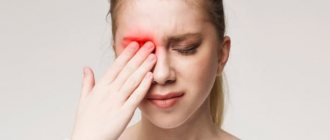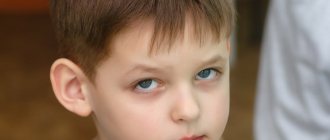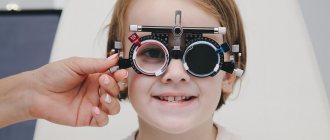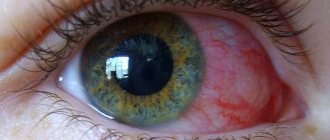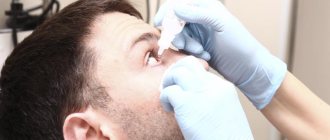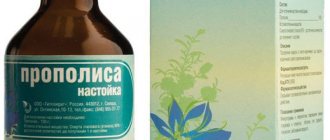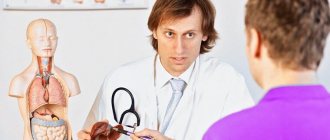A nervous tic is essentially an unintentional contraction of a stereotypical-looking muscle on the face, or, less commonly, a muscle in the neck. This deviation is expressed in small twitching attacks. Any person has experienced uncontrollable muscle twitching at least once in his life. This stereotypical shortening of the eyelid occurs in cases of severe mental or emotional overload.
Nervous eye tics or twitching of facial muscles are more common than others. In childhood, boys are predominantly at risk for developing nervous tics. In this case, drug treatment is not required for either children or adults. However, if the tic passes into the stage of a permanent phenomenon, it is necessary to begin treatment.
Symptoms
Depending on the muscle group affected, nervous tics are divided into types:
- Mimic – facial muscles are affected;
- Motor – skeletal muscles are affected, including the muscles of the limbs;
- Vocal – the muscles responsible for producing sounds suffer.
Common manifestations of the disease include:
- Small involuntary muscle contractions, which are characterized by their monotony;
- The appearance or intensification of a tic in a stressful, exciting situation;
- The appearance of screams, loud sighs;
- Constant anxiety and restlessness;
- Night sleep disturbance;
- Having trouble remembering and paying attention.
Diagnostics
Nervous tics are treated by a neurologist. He conducts a survey, with the help of which he tries to identify the suspected cause of the disease, and also conducts a full neurological examination.
Additional diagnostic methods include:
- General blood test, biochemical blood test - to detect a possible inflammatory process;
- X-ray examination of the skull bones, computed tomography, magnetic resonance imaging - to determine the localization of the pathological focus in the brain;
- Electroencephalography – identification of foci of increased impulse activity in the cerebral cortex.
Causes of nervous tics
The causes of tics are usually grouped as follows:
- primary tics
caused by psychogenic factors. In this case, there are no organic pathologies. The occurrence of a tic can be caused by stress, fear, depression, and neurosis. It is this type of tics that most often occurs in children. The cause of a nervous tic in a child can be psycho-emotional trauma, increased anxiety, obsessive fear, attention deficit hyperactivity disorder (ADHD); - secondary tics
. In this case, the tic is a consequence of any diseases that cause disruption of brain activity. These may be infectious diseases (encephalitis), intoxication, brain injury, cerebrovascular accidents; - hereditary tics.
Treatment
Primary nervous tics may disappear on their own, and therapy is aimed only at accelerating recovery. Common activities include:
- Maintaining a daily routine, creating psycho-emotional comfort;
- Communication with a psychotherapist;
- Drug therapy
- Treatment of secondary nervous tics consists of eliminating the cause of its occurrence and treating the underlying disease.
Many years of medical practice have shown that the earlier treatment for tics begins, the faster and more effectively the disease goes away. At the first consultation, medical specialists will tell you how to get rid of this disease and how it can be dangerous. In the future, doctors will develop a suitable therapy program, with the help of which the balance of the nervous system will be restored, and the disease will be completely eradicated.
You can get detailed information and make an appointment at the reception or by phone.
Norilsk Interdistrict Children's Hospital
Delyagin V.M.
Introduction. Tics in children and adolescents are a fairly common condition. Fortunately, a very small part of them require the prescription of psychopharmacological drugs. In the vast majority of cases, the matter is limited to correction of the regimen, psychosocial status, treatment of concomitant diseases, nonspecific sedative and adaptogenic therapy [1]. The pediatric challenge is to establish frank and complete interaction between the patient, his parents and the doctor, creating interdisciplinary connections, excluding organic causes, individualizing a treatment plan with minimal side effects and treating associated conditions before requiring referral of the patient to a neurologist or psychiatrist in a specialized clinic. Definition. According to the American Psychiatric Association, tics are “involuntary, sudden, rapid, repetitive, nonrhythmic, patterned movements or sounds” [2]. Tics are more complex movements than myoclonus, but much less smooth than choreic movements. Tics are classified as simple or complex, motor or vocal (Table 1). Simple motor tics are manifested by the movement of one muscle group, complex motor tics are manifested by the coordinated movement of several muscle groups (for example, grimacing, nodding the head and jerking the shoulders). Simple vocal tics are the production of simple sounds (the sound of choking, coughing, etc.), complex ones are the pronunciation of words or phrases. Simple tics are short, chopped, aimless movements or sounds. Complex tics are longer lasting and sometimes seem purposeful. Tics, depending on many conditions (emotions, somatic diseases) in the same child, can vary in location, severity, and frequency. Sometimes in adolescents, tics are preceded by an obsessive desire to move a group of muscles or sensory sensations. Older children Younger children are incapable of this. Transient tics are isolated or multiple motor or vocal tics that occur many times a day or almost every day for more than 4 months, but not more than 12 months. (hereinafter the definitions are for people under 18 years of age). Chronic motor or vocal tics - single or multiple (but not in combination!), occurring many times a day or on the vast majority of days, constantly or intermittently, for more than 1 year, provided there is no clear interval of more than 3 months. contract. Prevalence, age, gender. 1–5% of children experience episodes of tics. Tics most often manifest at the age of 5–7 years, more often in cities than in villages. In most cases, uncomplicated simple tics resolve well in adolescence and young adults. In 10% of children, tics become chronic. A sign of chronicity is an increase in tics and/or the addition of new motor and/or vocal manifestations at the age of 10 years and older. The number of boys with tics is 5–10 times higher than girls. There are no racial or ethnic predispositions. Possible causes, features of manifestations. There is no reliable information about the causes of motor tics. Most scientists suggest a genetic component (given the concentration of tics in families). Infectious and immune mechanisms are discussed. In particular, mothers suffering from autoimmune diseases are more likely to give birth to children with tics [3]. Chronic motor or vocal tics are associated with impaired dopamine metabolism in the brain. Tics can occur after stressful situations (parental divorce, hospital stay, fright). Tics are more common in children born in single-parent families to mothers with polyalgic syndrome. Tics are much more severe and almost always become chronic if they are combined with obsessive-compulsive disorders [4]. Children with tics are often characterized by general neuroticism, recorded even before the onset of tics, anxiety, poor sleep, selectivity of appetite, recurrent abdominal pain, and headaches. Tics intensify with fatigue, melancholy, and watching TV. Triggers for tics vary from person to person. Tics decrease with concentration, interesting activities, exercise, and relaxation. During sleep, the manifestations of tics decrease, but do not disappear completely. By the age of 18, with unexpressed tics and adequate therapy, almost half of all cases of motor and vocal disorders are successfully completed. Differential diagnosis (DD). When caring for a child or adolescent with tics, the pediatrician must exclude conditions that require consultation with specialists of a different profile and specific treatment. Tics are a leading symptom of Gilles de la Tourette syndrome (TS). TS is a neuropsychiatric disorder that begins in childhood and is characterized by multiple motor tics in combination with one or multiple vocal tics, occurring repeatedly during the day or on the vast majority of days for more than 1 year without a 3-month clear interval. Vocal tics begin as grunting, strangled sounds. Later they develop into involuntarily shouted words. In 50% it is scotolalia (coprolalia). The latter, in combination with tics, leads to social maladjustment and requires DD with schizophrenia. TS is often combined with a complex of obsessive and socially unacceptable gestures, attention deficit/hyperactivity disorder, and obsessive-compulsive disorders [5]. The latter are a combination of obsessive movements, which can be perceived as tics, with obsessive thoughts (obsessions), and various pathological fears (Table 2). In addition, other movement disorders may be mistakenly perceived as tics [6]. Dyskinesia or hyperkinesia are constant erratic movements of the facial muscles, trunk, limbs, enhanced by the fact that the patient must make opposite movements to maintain balance or tries to restrain involuntary movements, including them in meaningful ones. These movements are the first symptom of Hutchinson's disease and develop with an overdose of dopergic drugs in Parkinson's disease, as a complication of treatment with neuroleptics or antihistamines. In most cases, dyskinesia is the result of damage to the basal ganglia. Dystonia is often local, mostly painless, spasms, for example, blepharospasm, writer's cramp. A rare condition is generalized dystonia. The type of transmission is autosomal dominant (a/d) with partial penetrance. The gene is located on chromosome 9q. The disease begins in childhood with inversion and plantar fixation of the foot during walking. In severe cases, the disease progresses, and patients literally “twist” in grotesque positions. Mental development is usually not impaired. Rigidity – a feeling of resistance during passive movement; if this resistance is periodically interrupted for a short period, then they speak of the “gear wheel” symptom. Tremors are rhythmic oscillatory movements resulting from repeated contractions and relaxations of muscles. Tremors are classified by frequency (slow - 3-5 Hz; fast - 6-12 Hz), amplitude, rhythm, time of occurrence (rest tremor, during muscle activity). The causes of tremor are varied. Almost everyone experienced physiological tremor: a gentle, rapid trembling of outstretched fingers. Typical for anxiety, fear, fatigue, hypoglycemia, after drinking alcohol, large amounts of coffee (caffeine and other phosphodiesterase blockers). Close to physiological - tremor while taking corticosteroids. Benign hereditary (essential) tremor is slow, gentle, usually affecting the hands, head and voice. In 1/2 of the cases, the a/d type of transmission was proven. The tremor may be unilateral. It decreases or even stops completely at rest, but increases under the same conditions as the physiological one. It intensifies with age, becomes more noticeable and is mistakenly called senile. The resting tremor is small-amplitude, the frequency is 3–5 movements per second, and decreases with movements. Typical of Parkinson's disease is the movement of the thumb against the index finger - a “pill roller”. Parkinson's disease is an idiopathic slowly progressive degenerative disease of the central nervous system, characterized by resting tremor, slow, progressive movements, muscle rigidity and postural instability. The disease can begin in children and adolescents (juvenile parkinsonism), but the average age of onset is 57 years and older. Among people aged 40 years, this form of neurodegenerative disease affects 0.4% of the population, and over 65 years old – about 1%. In 60–80% of cases, Parkinson's disease begins with a resting tremor (4–8 Hz) of the “pill-roller” type, first in the fingers of one hand. The tremor is maximum at rest, decreases with movement and completely disappears in sleep, is expressed in the hands, less in the arms, and even less in the legs. As the disease progresses, rigidity, hypo- and akinesia increase, the tremor becomes less pronounced. Almost all patients are accompanied by depression, and 50% develop dementia. In many patients, tremor is absent; the clinical picture is dominated by rigidity syndrome. DD can be performed with essential tremor. But essential (benign hereditary) tremor is a tremor of movements, with an unchanged gait, and tremor in Parkinson's disease is primarily a resting tremor. It is much more difficult to distinguish from Parkinson's disease senile conditions with impoverished movements, tremor, shallow (rheumatic) gait, moderate depression and dementia. Anamnesis and information about the “natural course of the disease” help. Intention tremor is typical for diseases of the cerebellum, small tremor of outstretched arms and fingers is characteristic of thyrotoxicosis and alcoholism, more widespread is observed in liver diseases, reaching the amplitude of flapping wings in Wilson-Konovalov disease. These slow, irregular, rough movements (“liver pops”) of the patient's outstretched arms are typical of hepatic or other severe metabolic encephalopathy. According to electromyographic manifestations, they are more myoclonus (negative myoclonus), and not tics themselves. Chorea is rapid, non-repetitive movements that the patient often strives to incorporate into meaningfully controlled ones. Chorea can be a sign of rheumatic brain damage in young people (Sydenham's chorea), an isolated symptom (senile chorea), or a manifestation of Hutchinson's disease. Athetosis - slow worm-like movements of the limbs, can develop together with chorea, they are called choreoathetosis. Ballism - movements of the limbs that imitate the throwing of objects, most often this is a one-sided condition (hemiballism), it develops with damage (hemorrhage) to the subthalamic nucleus. Myoclonus is a short burst-like contraction of a muscle or group of muscles. Normal myoclonus sometimes occurs in some people during the process of falling asleep or during shallow sleep (“nocturnal myoclonus”). In essence, hiccups are myoclonic contractions of the diaphragm. The causes of pathological myoclonus can be severe metabolic disorders (uremia), degenerative diseases of the nervous system (Alzheimer's disease), slow viral infections (subacute sclerosing encephalitis, etc.), severe closed brain injuries, and hypoxic-ischemic damage. The DD of hyperkinesis is given in Table 3. Blepharospasm is involuntary squinting of the eyes. Closing the eyes when blinking occurs normally, but opening them causes a lot of difficulties for patients. In modern conditions, botulinum toxin is injected into the overactive muscle. Orofacial dyskinesia - grimace-like slow movements of the facial muscles (first described by Meigel, known as the syndrome under his name), also described as Bruegel's syndrome, named after the artist, who willingly depicted grimacing faces in his paintings. The DD of hyperkinesis is presented in Table 3 [7]. Additional studies for tics (EEG, polysomnography, imaging techniques, Holter heart rate monitoring, biochemical tests, etc.) are necessary only to exclude possible somatic and neurological disorders occurring under the guise of tics. There is no specific test for childhood tics. Treatment is carried out comprehensively, taking into account the severity, characteristics of tics, the general condition of the child, and his social status. • Psychological correction. Behavior of parents, teachers, peers. Convince the child that nothing bad is happening, that many people have tics. Do not focus the child’s attention on tics, do not persuade him to control them (tics are involuntary), which only leads to neuroticism. Tics attract the attention of peers in kindergarten or school. Interaction with educators and teachers is necessary. Teachers should remove the child from the group if the tics worsen so that the child can calm down. The child must be ready to answer a tactless question about tics without conflict and present them as a passing condition. • Mode. Relieving anxiety before bed, avoiding noisy games. Elimination of traumatic situations and regulation of family and school relationships, if necessary, with the help of a psychologist. It is recommended to limit computer games, watch television programs, exercise, and spending time in the fresh air are beneficial. In cases of severe tics, especially those combined with obsessive-compulsive disorders, treatment with antipsychotics is carried out in specialized conditions. Aminobutyric acid derivatives are often used in widespread pediatric practice. Aminophenylbutyric acid hydrochloride (Anvifen) is known as such a drug. Anvifen is a nootropic drug that combines a tranquilizing effect with an activating effect, has antiplatelet, antioxidant and some anticonvulsant effects. The drug improves the functional state of the brain by normalizing its metabolism and influencing cerebral blood flow. When taken as a course, Anvifen increases physical and mental performance (attention, memory, speed and accuracy of sensory-motor reactions). Reduces manifestations of asthenia (improves well-being, increases interest and initiative/motivation for activities) without sedation or agitation. Anvifen helps reduce feelings of anxiety, tension and restlessness, and normalizes sleep. In addition, the form of the drug is convenient for use. A small dosage (50 mg) ensures compliance with treatment conditions, excluding the notorious “breaking of the tablet” (250 mg), which is inevitable when using analogue drugs and is unacceptable when used in children. The capsule form of Anvifen is advantageous with its extremely low content of excipients, which reduces the likelihood of adverse reactions. Thus, Anvifen is a unique drug and its use is fully justified in children experiencing stress reactions at school and at home, with overload and sleep disturbances. In our practice, we used Anvifen in 15 children aged 5–7 years for sleep disturbances, general anxiety, and night fears. According to the results of observation, a significant improvement was noted. After a 2-week course, night awakenings stopped, appetite improved, children became calmer, and the process of preparing homework was easier. Conclusion. Tics are a common problem in childhood and adolescence. It is necessary to exclude conditions that require specialized examination and treatment, and to exclude the primary disease. Correction of the regime and psychological climate is recommended. The drug Anvifen has a positive effect on childhood anxiety, worry, and fears.
References 1. Chadehumbe M., Greydanus D., Feucht C., Patel D. Pediatric Psychopharmacology in the 21st Century Psychopharmacology of Tic Disorders in Children and Adolescents // Pediatric Clinics North Amer. 2011. Vol. 58. Issue 1. P. 259–272. 2. Franklin M., Harrison J., Benavides K. Anxiety Disorders Obsessive-Compulsive and Tic-Related Disorders // Child and Adolescent Psychiatric Clinics North Amer. 2012. Vol. 21. Is. 3. P. 555–571. 3. Murphy T., Storch E., Turner A. et al. Maternal history of autoimmune disease in children presenting with tics and/or obsessive-compulsive disorder // J. Neuroimmunol. 2010. Vol. 229.Is. 1–2. P. 243–247. 4. Kraft J., Dalsgaard S., Obel C. et al. Prevalence and clinical correlates of tic disorders in a community sample of school-age children // Eur. Child Adolesc. Psychiatry. 2012. Vol. 21. P. 5–13. 5. Jankovic J. Tourette's syndrome // N. Engl. J. Med. 2001. Vol. 345. P. 1184–1192. 6. Siegenthaler W. (Hrsg.) Differential diagnosis innere Krankheiten. – Georg Thieme Verlag, 2005. 7. Illing S., Spranger S. (Hrsg.) Paediatrie. Junjiohann Verlaggesellschaft. – Stuttgart, 2005. – 657 s.
Russian Medical Journal
